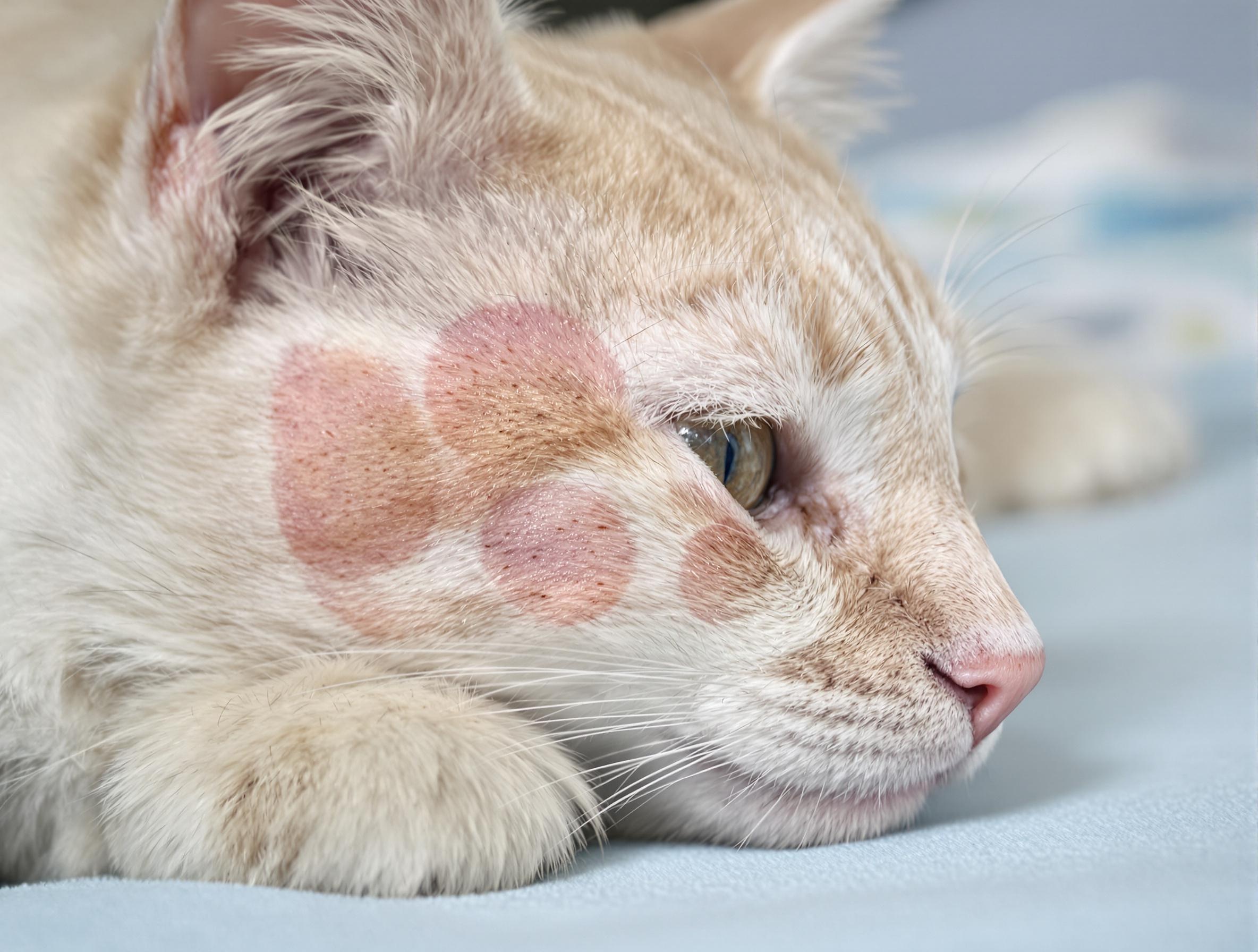
Key takeaways:
- Fleas can bite humans but don’t breed on humans.
- Understanding the flea lifecycle helps effectively control and prevent infestations in your home.
- Simple home and pet care steps are crucial in preventing flea infestations.
One of the many hidden worries you might have when your cat has fleas is—can these fleas live on me, too? The answer, however, is not so straightforward. The fact is that fleas can jump up to 13 inches high—which explains why you may get bitten.
But fleas don’t actually live on humans. They much prefer a furry animal, like cats, to reproduce, leading to major ‘infestations’ on your pet. It doesn’t end there, though. Although fleas cannot directly infest humans, in rare cases, they might cause infections through bites or if ingested by us humans.
At PetHealthMD we understand the need for protecting your household and pets. Which is why we aim to guide pet parents through proven methods for caring for the health and well-being of their feline friends.
Humans and fleas: how do they affect us?
As we mentioned above, fleas do not live or breed on humans. They do, however, bite us occasionally, causing itchiness, redness, and, in rare cases, certain infections like:
- Cat Scratch Disease (CSD): Caused by the Bartonella bacteria, which fleas can pass to cats and, in turn, to humans through scratches or bites. Symptoms include fever, swollen lymph nodes, and fatigue.
- Murine Typhus: This one’s less common but still worth knowing about. Fleas infected with Rickettsia bacteria can pass this illness to humans through bites. It usually causes flu-like symptoms—fever, body aches, headaches, and sometimes a rash.
- Flea-borne Tularemia: Though rare, fleas can carry Francisella tularensis bacteria, leading to tularemia. It can cause fever, skin ulcers, and swollen lymph nodes if transmitted through a bite.
- Tapeworm Infection: If a flea carrying tapeworm larvae gets accidentally swallowed—often by young children playing with pets—it can lead to a tapeworm infection. While not dangerous, it’s something you’d want to avoid.
These infections are treatable through medicine and symptomatic treatments, however, do not try to cure these by yourself, if you notice any signs visit your healthcare provider immediately.

Recognizing and treating symptoms of flea bites in humans
Even if flea bites aren’t always infectious, they can cause mild discomfort to you. Understanding what to look for and how to treat these bites will help you stay comfortable while addressing the underlying issue.
Common symptoms:
- Notice small red bumps that appear in groups or lines, especially around ankles and lower legs
- Spot reddish areas with a small dark center surrounded by a lighter ring
- Experience persistent itching or mild discomfort in affected areas
- Watch for increased skin sensitivity, which some people may develop due to flea saliva
To manage the itchiness or redness, you can follow a few simple steps to find relief:
- Wash affected areas gently with mild soap and cool water to reduce irritation
- Apply an over-the-counter anti-itch cream or calamine lotion to soothe discomfort
- Place a cool compress on irritated skin to reduce swelling and ease itching
Contact your healthcare provider if you develop unusual swelling warmth around bite areas or if symptoms worsen for you.
The flea life cycle: key to controlling flea infestations
Fleas don’t appear out of nowhere! They have a well-defined life cycle that helps them thrive in your home. The process starts with tiny eggs laid in a cat’s fur. Within a couple of days, these eggs fall onto carpets, bedding, and furniture.
Over the next few weeks, larvae hatch and settle in dark areas, feeding on organic debris. After a week or so, they form protective cocoons and enter the pupal stage, where they can wait for the perfect time to emerge. Once adult fleas appear, they immediately seek out a warm-blooded host, i.e. your cats!
Knowing where fleas develop is key to stopping them from hatching at all. The truth is that most of the flea population isn’t on your pet but in your environment! So, prevention must start from there.
Practical tips to prevent flea spread from cats to humans
By now, we all must be on the same page—preventing fleas is the best defense for you and your feline pet. Preventing these pests will require you to use a multi-pronged approach like:
- Applying veterinarian-approved monthly preventatives to your cat. Products like NexGard COMBO provide ongoing protection, while Capstar offers fast relief during active infestations.
- Maintaining a clean living space by vacuuming carpets, furniture, and floor cracks daily, especially in areas where your cat rests. Wash pet bedding weekly in hot water to eliminate any parasites and their eggs.
- Treat indoor spaces with specialized carpet sprays and foggers, focusing on shaded areas beneath furniture. This creates a protective barrier between your living space and potential parasites.
- Use a fine-toothed flea comb during regular grooming sessions to detect parasites early. This helps prevent transmission between your cat and family members while strengthening your bond through gentle care.
- Safeguard your outdoor environment with pet-safe treatments, particularly in shaded areas. Limit your cat’s exposure to wildlife by creating an enriching indoor environment that satisfies their natural instincts.
If you’re looking to get your cat started on any monthly preventative treatments, visit your veterinarian first to formulate a treatment plan suited for your pet.

Common queries pet owners have about fleas
While we’ve covered the basics of fleas, there are plenty of other things pet owners wonder about. Here are some common flea-related concerns that you might not have thought about yet.
1. Can fleas survive in my home without a pet?
Yes, fleas can survive in your home even if you don’t currently have a pet. Flea eggs, larvae, and pupae can remain dormant in carpets, furniture, and crevices for weeks or even months, waiting for a host to appear. If a pet or even a human walks by, the fleas can emerge and start looking for a meal.
2. Can fleas travel on clothes or shoes?
Fleas don’t typically live on clothing, but they can hitch a ride on your shoes, socks, or pant legs if you’ve been in an infested area. This is how fleas can spread from one location to another, even without direct pet contact.
3. Do fleas prefer certain people over others?
Yes, some people may experience more flea bites than others. Fleas are attracted to body heat, movement, and carbon dioxide. People who produce more body heat or sweat slightly more may be more attractive to fleas. Additionally, some individuals may have stronger allergic reactions to flea bites, making them more noticeable.
4. Can fleas infest my bed?
Fleas are more likely to be found in pet bedding than in human beds, but they can still end up in your sheets if a pet with fleas sleeps with you. However, they won’t stay there permanently, as they prefer to be on a warm-blooded host rather than smooth surfaces like sheets or mattresses.
5. Can fleas drown in water?
Yes, fleas can drown, but they have a strong resistance to water. A simple rinse won’t kill them instantly, but prolonged submersion in soapy water can break the surface tension and lead to drowning. This is why flea baths with specially formulated shampoos can be effective for pets.
6. Can fleas become resistant to treatments?
Over time, fleas can develop resistance to certain flea treatments, especially if the same product is used repeatedly without alternating methods. If you notice flea treatments becoming less effective, consult your veterinarian about switching to a different active ingredient.
7. What temperature kills fleas?
Fleas thrive in warm, humid environments, but extreme heat and cold can kill them. Washing pet bedding and clothing in water hotter than 95°F (35°C) can kill fleas and their eggs. On the other hand, freezing temperatures below 32°F (0°C) for an extended period can also kill flea eggs and larvae.
A healthy home for pets and people
Preventing flea infestations starts with understanding your power as a pet parent. Your consistent care makes all the difference. Simple steps like regular pet treatments, thorough home cleaning, and proper yard maintenance create strong protection for your entire family.
Keep your beloved pets comfortable by maintaining their monthly flea treatments and annual health checks. Want to understand more about flea prevention? Browse PetHealthMD’s complete collection of flea prevention resources and product recommendations – we’re here to help you create a happy, healthy home for your furry family members.
If you’ve visited your vet and are looking for recommended flea treatments, you can find all the best brands easily at PetMeds. We have vet-approved treatments and preventative solutions that will help you live a happy and flea-free life with your pet!





